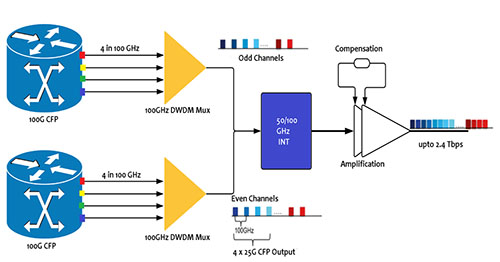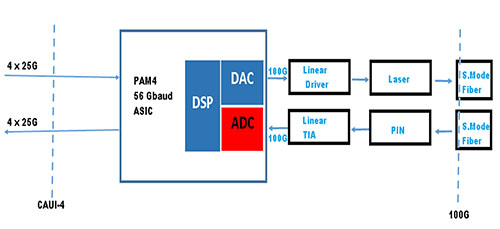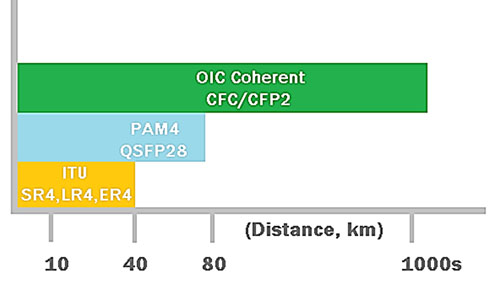The ever-growing demand for higher data transfer rate in data centers, cloud services, and mobile data traffic has forced access streams from 2.5 to 100 Gb/s. Still, the demand is increasing for optical fiber systems capable of handling beyond 100Gb/s without a stop. In the current scenario QSFP28 optical transceivers such as LR4, ER4, CWDM4, SR4, and PSM4, etc. are being used for a transmission distance of 25km maximum. For tens of meters, we have DAC, 100G AOC and breakout cables available. Whereas, SR10, ER4, and LR4 are some 100G CFP/CFP2 modules which support transmission over 150m to 40km distances.
Changing Dynamics in the Telecom Sector
In recent years, we have seen significant players from the telecom sector in a quest for better 100G DWDM technologies, superior hardware, and flexible protocols for their high capacity and extended distance services. Coherent 100G DWDM (Dense Wavelength Division Multiplexing) transceivers are vastly adapted for 100G long-distance application, and then more sophisticated technologies such as PAM4 are developed to handle length and bandwidth related constraints for 100G metro networks. In this post, we are going to discuss the issues on 100G PAM4 and coherent DWDM transceivers.
Quick Fact:
According to Infonetics research; by the end of 2019 100G will make up over 50% of the data center and up to 95% of telecom optical transceiver transmission capacity.
100G DWDM Transceivers - An Overview
In recent years, the implementation of 100G DWDM technologies remains focused on coherent DWDM (Dense Wavelength Division Multiplexing) optical transceiver - CFP and CFP2. In 2016, Inphi came ahead with pluggable PAM4 QSFP28 DWDM transceivers. These 100G transceivers can support up to 80km data center interconnect or DCI. Being an alternative for 100G DWDM coherent transceiver, the PAM4 QSFP28 DWDM transceiver received quite overwhelmingly. A new discussion got erupted after the commercial launch of this new product. Understanding the characteristics and capabilities of these two types of 100G capable transceivers can help you in choosing the right one!
100G Coherent CFP/CFP2 vs. PAM4 QSFP28
There are some significant differences between coherent CFP/CFP2 transceivers and QSFP28 PAM4 transceivers. However, when it comes about 100G applications, they do have some similarities also. You can find details about these optical modules in the following passages.
Coherent CFP - Time Tested 100G Companion
- CFP-DCO
- CFP-DCO comes with an integrated digital signal processing chip (DSP). Thus, they do not need standalone DCMs (Dispersion Compensation Modules). This is what makes them different and in some cases superior to QSFP28. Besides this, they come with built-in electronic compensation dispersion. Although the integrated DSP adds cost in components and requires more power, it relieves the switch manufacturers from incorporating DSPs to their equipment. Coherent CFPs offers data transmission over and beyond 1000km distance between sites.
- CFP2-ACO
- Concerning width, the CPF2-ACO is half of the CFP. Available CFP2 type coherent DWDM transceivers are analog and need a dedicated DSP (digital signal processor) on the host board. Without a separate DSP full rewards of the coherent elements cannot be achieved. So, CPF2-ACO is more suitable for switch vendors who already have such a DSP fitted. Understandably, it adds additional power consumption and cost on the main board.
- CFP2-DCO
- Back in December 2017, Acacia Communications announced the commercial launch of its CFP2-DCO. This digital coherent optical module supports both 100-Gbps and 200-Gbps operations. The CFP2-DCO comes with an integrated DSP ASIC and is costlier than its predecessor CPF2 ACO. However, overall line card cost using CFP2-ACOs versus CFP2-DCOs might shrink considerably. For sure CFP2-DCO can address a broad range of applications in a compact form factor as it offers high performance at low power consumption.


QSFP28 PAM4 – Cost Effective Enabler of 100G
Binary NRZ modulation format was in use for 40 and 100G long-haul transmission networks before the commercial availability of PAM4. To encode two bits of data PAM4 comes with four distinct levels - effectively doubling the bandwidth of a connection. These days the single-wavelength PAM4 modulation structure is considered as the most efficient and cost-effective enabler of 100G and beyond. The available PAM4 signaling enabled 100G DWDM transceiver is in QSFP28 form factor. Thus, customers willing to build an embedded DWDM network can proceed with using this transceiver in the switch directly. In this regard, it is a cost-effective and simple solution. However, there are some pre-requisites as well: It requires amplification to move out from the blocks and dispersion compensation is also needed in networks > 5-6km. Therefore, an additional DWDM multiplexer with dispersion compensation and amplification system is necessary for DCI or data center interconnect. Moreover, the addition of a QSFP28 PAM4 module into an already operating DWDM network is only possible if the host network has the right amplification system and dispersion compensation modules in place; if the host network does not have compatible DCM and amplification system than changes will be required before a QSFP28 PAM4 can be added to the system.
100G Pluggable Transceivers have a definite edge!
Data centers can utilize transponders and pluggable receivers in any combination as per their specific requirements. The popular DWDM technology is being extended to 200G line speeds, helping keep complexities and cost factor out of Datacom networking. In comparison to sub-10G services where multi-channel C/DWDM networks were enabled by passive multiplexers, DWDM will be the multiplexer for 100G systems. Another benefit of having 100G pluggable transceivers is that they allow enterprises to reap the full advantages of flexible open line networking. The following exhibit is showing a brief comparison of various available networking options in terms of distance:

Conclusion: 100G PAM4 QSFP28 or Coherent CFP?
Well, there is nothing like a rule of thumb to be followed here. While deploying DWDM transceivers based 100G DWDM long distance network the available equipment, existing configuration and required transmission distance should be kept in mind before proceeding with a particular class of pluggable modules.
 English
English
 Deutsch
Deutsch
 Espaniol
Espaniol










